
DoubleVerify (DV)
We’re cautious of DoubleVerify. Its decelerating growth and falling profitability suggest it’s struggling to scale down costs as demand fades.― StockStory Analyst Team
1. News
2. Summary
Why We Think DoubleVerify Will Underperform
Using advanced analytics to evaluate over 17 billion digital ad transactions daily, DoubleVerify (NYSE:DV) provides AI-powered technology that verifies digital ads are viewable, fraud-free, brand-suitable, and displayed in the intended geographic location.
- Operating margin dropped by 1.8 percentage points over the last year as the company focused on expansion rather than profitability
- Extended payback periods on sales investments suggest the company’s platform isn’t resonating enough to drive efficient sales conversions
- A consolation is that its software is difficult to replicate at scale and leads to a premier gross margin of 82%


DoubleVerify’s quality doesn’t meet our hurdle. We’d search for superior opportunities elsewhere.
Why There Are Better Opportunities Than DoubleVerify
Why There Are Better Opportunities Than DoubleVerify
DoubleVerify’s stock price of $10.77 implies a valuation ratio of 2.2x forward price-to-sales. DoubleVerify’s valuation may seem like a great deal, but we think there are valid reasons why it’s so cheap.
Cheap stocks can look like a great deal at first glance, but they can be value traps. They often have less earnings power, meaning there is more reliance on a re-rating to generate good returns - an unlikely scenario for low-quality companies.
3. DoubleVerify (DV) Research Report: Q3 CY2025 Update
Digital ad verification company DoubleVerify (NYSE:DV) fell short of the markets revenue expectations in Q3 CY2025, but sales rose 11.2% year on year to $188.6 million. Next quarter’s revenue guidance of $209 million underwhelmed, coming in 0.9% below analysts’ estimates. Its non-GAAP profit of $0.22 per share was 17.4% below analysts’ consensus estimates.
DoubleVerify (DV) Q3 CY2025 Highlights:
- Revenue: $188.6 million vs analyst estimates of $190.2 million (11.2% year-on-year growth, 0.8% miss)
- Adjusted EPS: $0.22 vs analyst expectations of $0.27 (17.4% miss)
- Adjusted EBITDA: $65.85 million vs analyst estimates of $62.2 million (34.9% margin, 5.9% beat)
- Revenue Guidance for Q4 CY2025 is $209 million at the midpoint, below analyst estimates of $210.8 million
- EBITDA guidance for Q4 CY2025 is $79 million at the midpoint, above analyst estimates of $77.86 million
- Operating Margin: 11.2%, down from 15.2% in the same quarter last year
- Free Cash Flow Margin: 20.7%, similar to the previous quarter
- Market Capitalization: $1.80 billion
Company Overview
Using advanced analytics to evaluate over 17 billion digital ad transactions daily, DoubleVerify (NYSE:DV) provides AI-powered technology that verifies digital ads are viewable, fraud-free, brand-suitable, and displayed in the intended geographic location.
DoubleVerify's software platform acts as a critical intermediary in the digital advertising ecosystem, helping brands ensure their ad dollars aren't wasted on fraudulent or inappropriate placements. The company's technology integrates across the entire digital advertising landscape, including programmatic platforms, social media channels, and digital publishers, measuring ads across all key digital media channels like social, video, mobile apps, and connected TV.
The core of DoubleVerify's offering is the DV Authentic Ad metric, which evaluates multiple quality factors for digital advertisements. Beyond fraud detection, the company's solutions analyze content for brand suitability, ensuring ads don't appear alongside potentially harmful content across over 40 languages. The platform also measures viewability (whether ads can actually be seen by users) and confirms geographic targeting requirements are met.
Additional offerings include DV Authentic Attention, which measures how users engage with ads, and Custom Contextual solutions that help advertisers match their content to relevant environments without relying on third-party cookies. Following its acquisition of Scibids in 2023, DoubleVerify also provides AI-powered campaign optimization tools.
The company generates revenue based on the volume of media transactions it measures, serving over 1,800 customers including many global brands across industries like consumer packaged goods, financial services, telecommunications, and technology.
4. Advertising Software
The digital advertising market is large, growing, and becoming more diverse, both in terms of audiences and media. As a result, there is a growing need for software that enables advertisers to use data to automate and optimize ad placements.
DoubleVerify's competitors include Integral Ad Science (NASDAQ:IAS), Oracle's Moat (NYSE:ORCL), Human Security (formerly White Ops), and Google's Active View (NASDAQ:GOOGL).
5. Revenue Growth
A company’s long-term sales performance can indicate its overall quality. Any business can have short-term success, but a top-tier one grows for years. Luckily, DoubleVerify’s sales grew at an impressive 26.9% compounded annual growth rate over the last five years. Its growth beat the average software company and shows its offerings resonate with customers, a helpful starting point for our analysis.

Long-term growth is the most important, but within software, a half-decade historical view may miss new innovations or demand cycles. DoubleVerify’s annualized revenue growth of 17.2% over the last two years is below its five-year trend, but we still think the results suggest healthy demand. 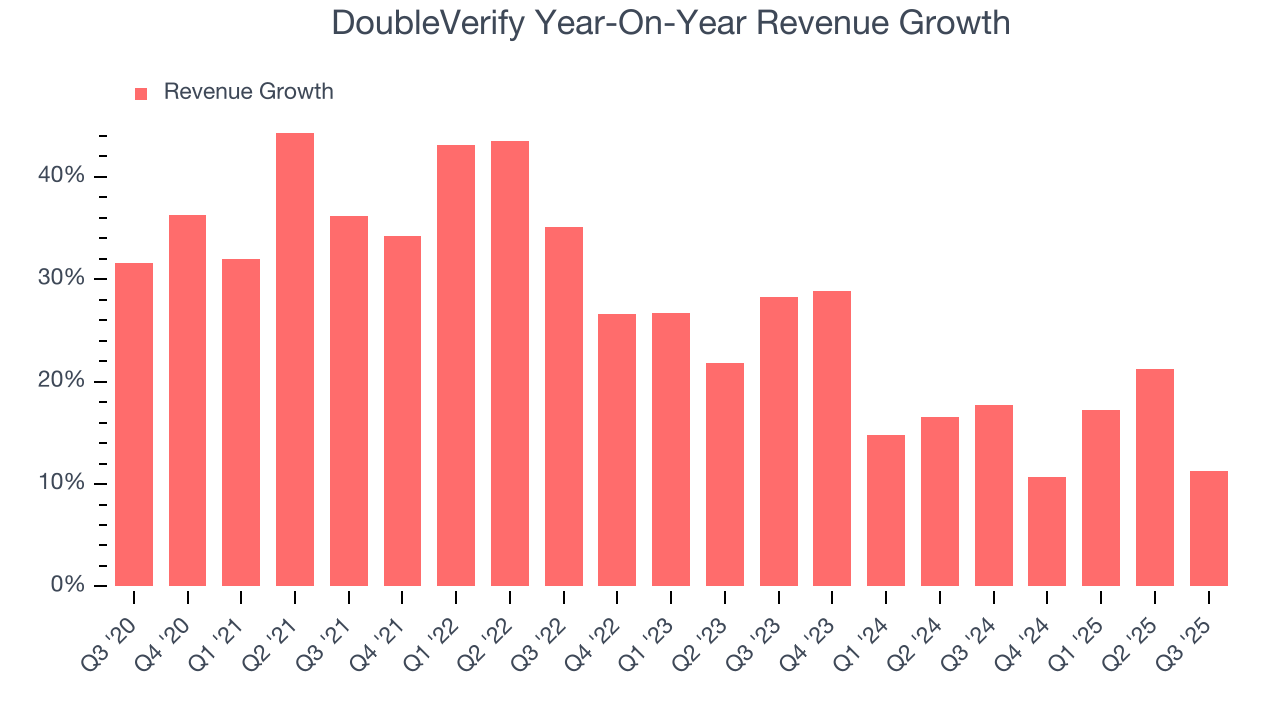
This quarter, DoubleVerify’s revenue grew by 11.2% year on year to $188.6 million but fell short of Wall Street’s estimates. Company management is currently guiding for a 9.6% year-on-year increase in sales next quarter.
Looking further ahead, sell-side analysts expect revenue to grow 10.5% over the next 12 months, a deceleration versus the last two years. This projection doesn't excite us and suggests its products and services will see some demand headwinds. At least the company is tracking well in other measures of financial health.
6. Customer Acquisition Efficiency
The customer acquisition cost (CAC) payback period measures the months a company needs to recoup the money spent on acquiring a new customer. This metric helps assess how quickly a business can break even on its sales and marketing investments.
DoubleVerify’s recent customer acquisition efforts haven’t yielded returns as its CAC payback period was negative this quarter, meaning its incremental sales and marketing investments outpaced its revenue. The company’s inefficiency indicates it operates in a competitive market and must continue investing to grow.
7. Gross Margin & Pricing Power
What makes the software-as-a-service model so attractive is that once the software is developed, it usually doesn’t cost much to provide it as an ongoing service. These minimal costs can include servers, licenses, and certain personnel.
DoubleVerify’s robust unit economics are better than the broader software industry, an output of its asset-lite business model and pricing power. They also enable the company to fund large investments in new products and sales during periods of rapid growth to achieve higher profits in the future. As you can see below, it averaged an excellent 82% gross margin over the last year. That means DoubleVerify only paid its providers $17.98 for every $100 in revenue.
The market not only cares about gross margin levels but also how they change over time because expansion creates firepower for profitability and free cash generation. DoubleVerify has seen gross margins improve by 0.6 percentage points over the last 2 year, which is slightly better than average for software.
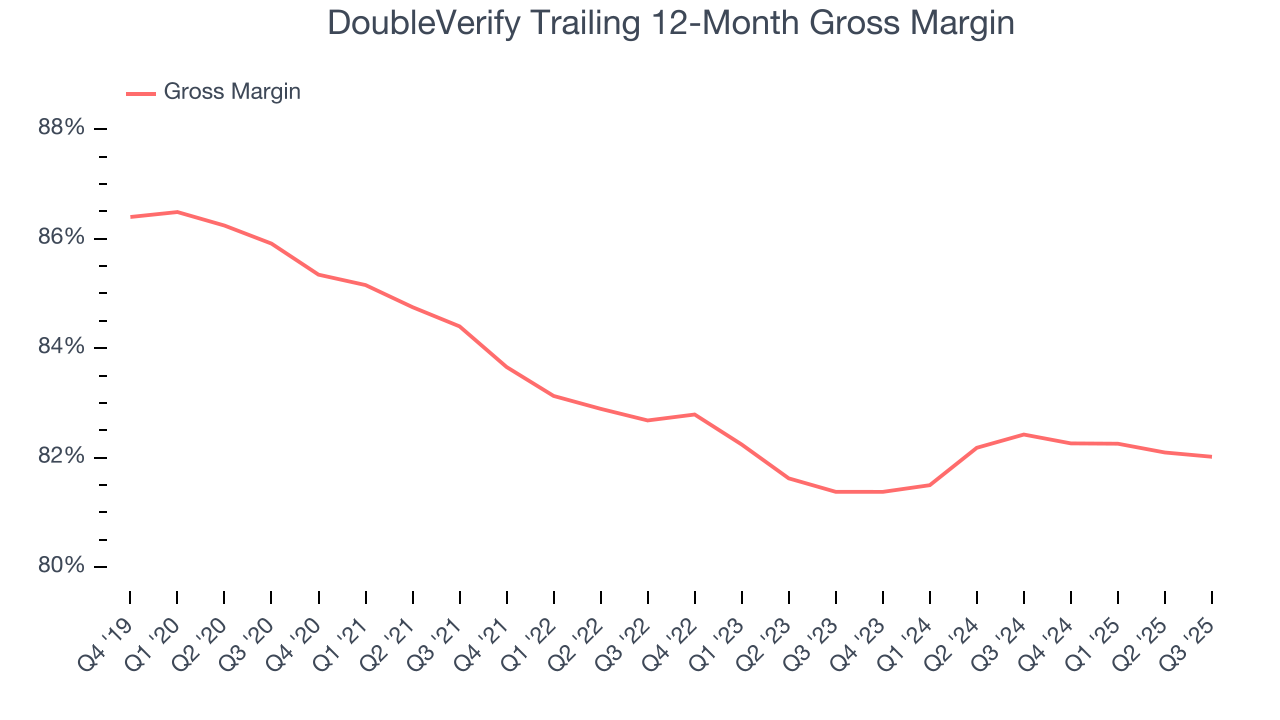
This quarter, DoubleVerify’s gross profit margin was 82.3%, in line with the same quarter last year. On a wider time horizon, the company’s full-year margin has remained steady over the past four quarters, suggesting its input costs have been stable and it isn’t under pressure to lower prices.
8. Operating Margin
Many software businesses adjust their profits for stock-based compensation (SBC), but we prioritize GAAP operating margin because SBC is a real expense used to attract and retain engineering and sales talent. This is one of the best measures of profitability because it shows how much money a company takes home after developing, marketing, and selling its products.
DoubleVerify has been an efficient company over the last year. It was one of the more profitable businesses in the software sector, boasting an average operating margin of 10.9%. This result isn’t surprising as its high gross margin gives it a favorable starting point.
Analyzing the trend in its profitability, DoubleVerify’s operating margin decreased by 1.8 percentage points over the last two years. This raises questions about the company’s expense base because its revenue growth should have given it leverage on its fixed costs, resulting in better economies of scale and profitability.
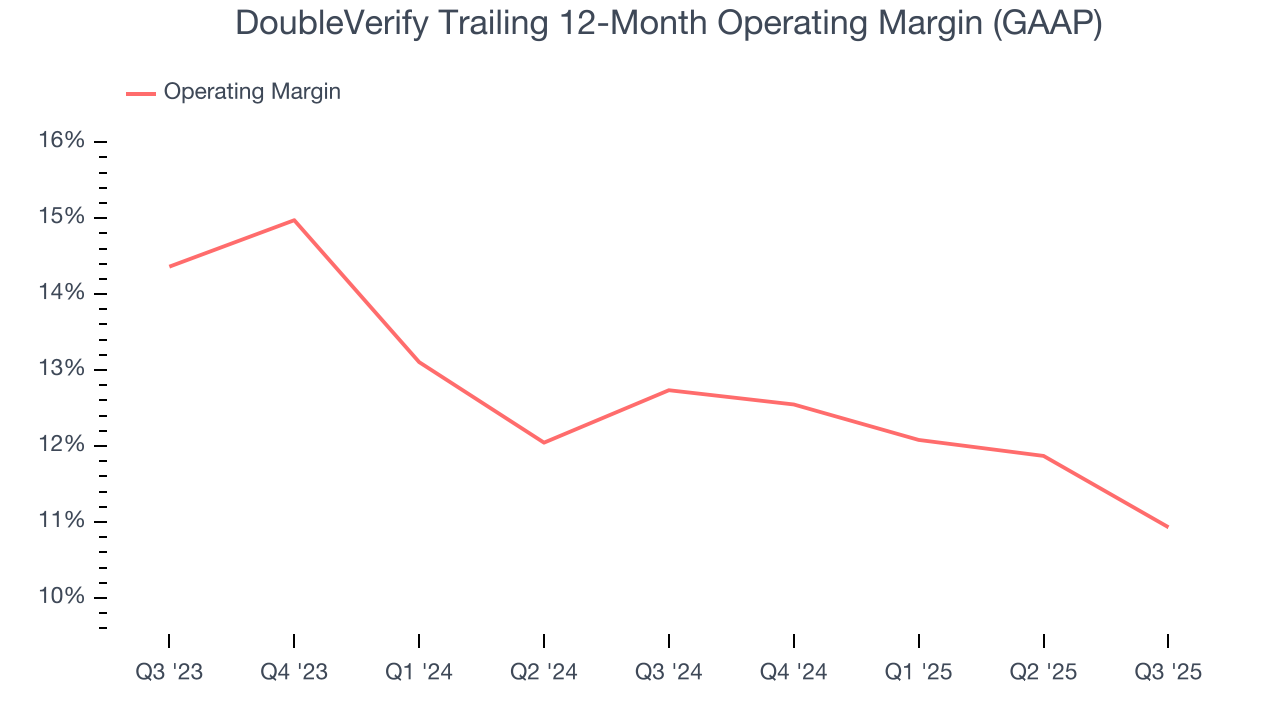
In Q3, DoubleVerify generated an operating margin profit margin of 11.2%, down 4 percentage points year on year. Since DoubleVerify’s operating margin decreased more than its gross margin, we can assume it was less efficient because expenses such as marketing, R&D, and administrative overhead increased.
9. Cash Is King
Although earnings are undoubtedly valuable for assessing company performance, we believe cash is king because you can’t use accounting profits to pay the bills.
DoubleVerify has shown impressive cash profitability, driven by its attractive business model that gives it the option to reinvest or return capital to investors. The company’s free cash flow margin averaged 19.2% over the last year, better than the broader software sector.
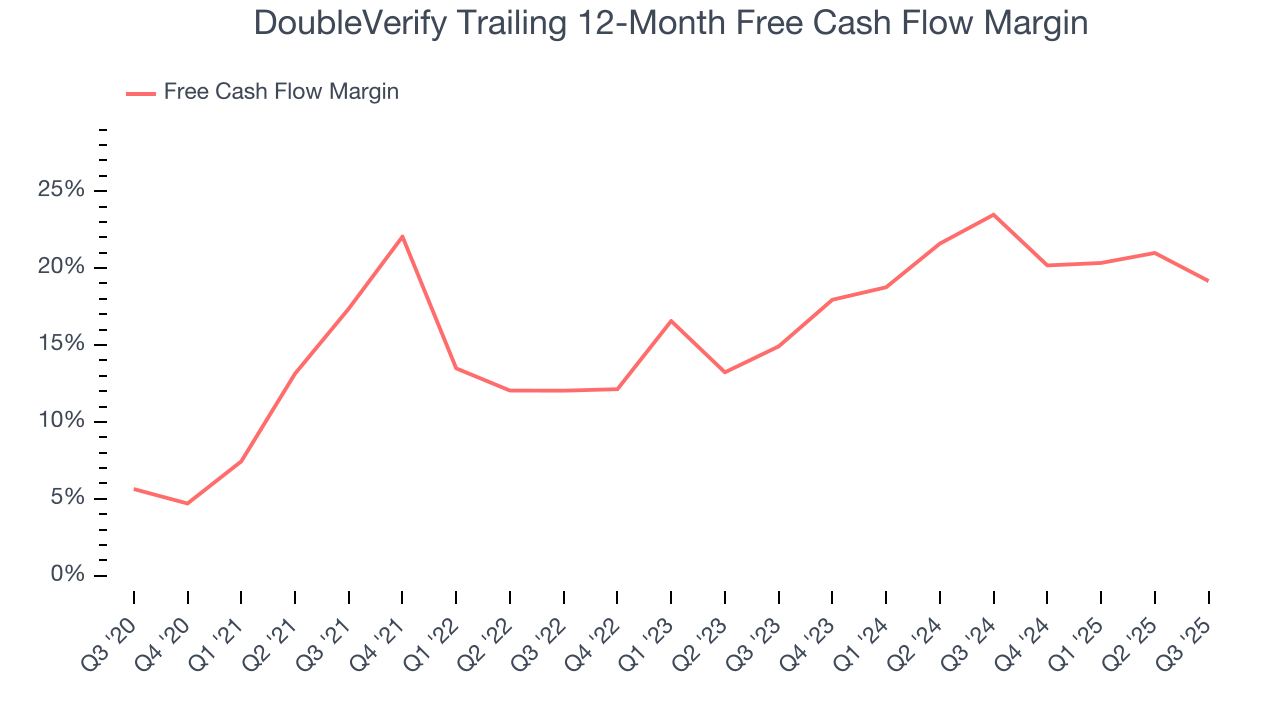
DoubleVerify’s free cash flow clocked in at $39.04 million in Q3, equivalent to a 20.7% margin. The company’s cash profitability regressed as it was 7.8 percentage points lower than in the same quarter last year, but it’s still above its one-year average. We wouldn’t read too much into this quarter’s decline because investment needs can be seasonal, leading to short-term swings. Long-term trends carry greater meaning.
Over the next year, analysts predict DoubleVerify’s cash conversion will improve. Their consensus estimates imply its free cash flow margin of 19.2% for the last 12 months will increase to 22.3%, giving it more flexibility for investments, share buybacks, and dividends.
10. Balance Sheet Assessment
Businesses that maintain a cash surplus face reduced bankruptcy risk.
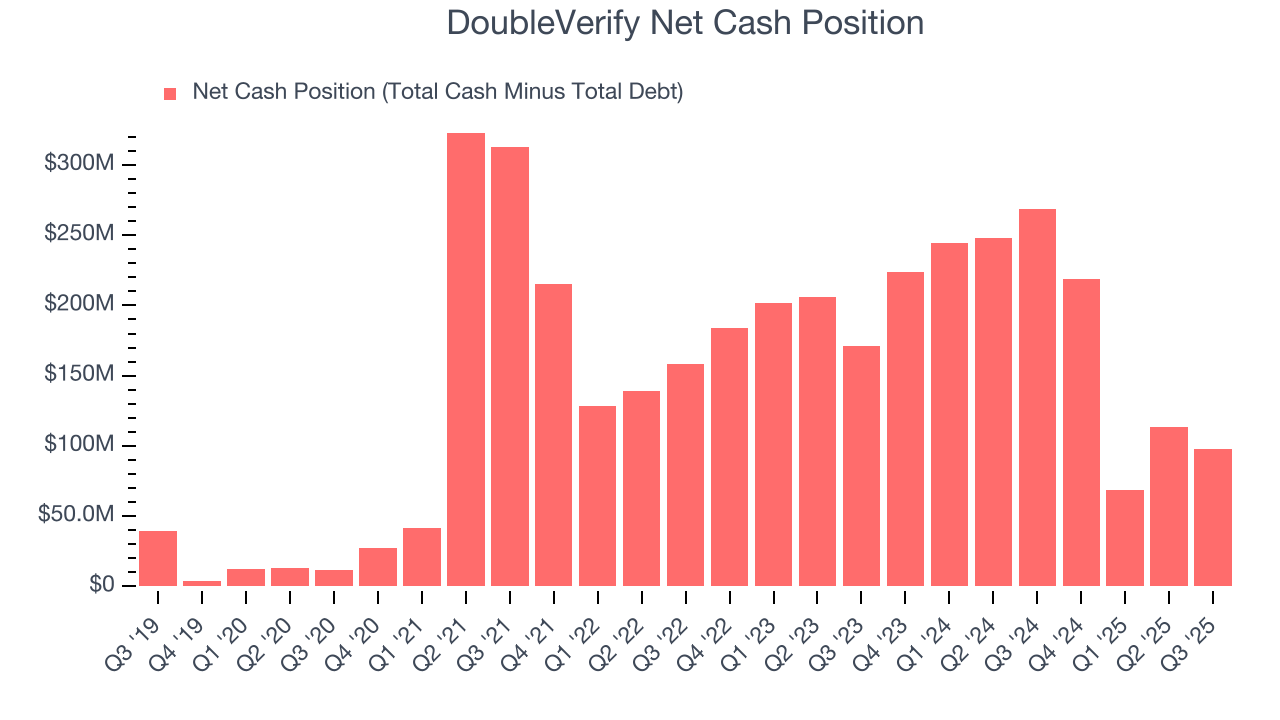
DoubleVerify is a profitable, well-capitalized company with $200.7 million of cash and $103.1 million of debt on its balance sheet. This $97.62 million net cash position is 5.4% of its market cap and gives it the freedom to borrow money, return capital to shareholders, or invest in growth initiatives. Leverage is not an issue here.
11. Key Takeaways from DoubleVerify’s Q3 Results
We enjoyed seeing DoubleVerify beat analysts’ EBITDA expectations this quarter. We were also glad its EBITDA guidance for next quarter slightly exceeded Wall Street’s estimates. On the other hand, its revenue guidance for next quarter slightly missed and its revenue fell slightly short of Wall Street’s estimates. Overall, this was a weaker quarter. The stock traded down 7.6% to $10.13 immediately following the results.
12. Is Now The Time To Buy DoubleVerify?
Updated: December 4, 2025 at 9:24 PM EST
Before making an investment decision, investors should account for DoubleVerify’s business fundamentals and valuation in addition to what happened in the latest quarter.
DoubleVerify isn’t a terrible business, but it isn’t one of our picks. Although its revenue growth was strong over the last five years, it’s expected to deteriorate over the next 12 months and its declining operating margin shows it’s becoming less efficient at building and selling its software. And while the company’s admirable gross margin indicates excellent unit economics, the downside is its customer acquisition is less efficient than many comparable companies.
DoubleVerify’s price-to-sales ratio based on the next 12 months is 2.2x. While this valuation is fair, the upside isn’t great compared to the potential downside. We're fairly confident there are better investments elsewhere.
Wall Street analysts have a consensus one-year price target of $13.92 on the company (compared to the current share price of $10.82).
Although the price target is bullish, readers should exercise caution because analysts tend to be overly optimistic. The firms they work for, often big banks, have relationships with companies that extend into fundraising, M&A advisory, and other rewarding business lines. As a result, they typically hesitate to say bad things for fear they will lose out. We at StockStory do not suffer from such conflicts of interest, so we’ll always tell it like it is.





